Cinema of Azerbaijan
Cinema of Azerbaijan dates back to the 19th century and the country was one of the first countries in the world to be involved in cinematography.[4] The first Azerbaijani film was a 30 second long, silent film called The Oil Gush Fire in Bibiheybat, which was recorded using the cinematograph.
| Cinema of Azerbaijan | |
|---|---|
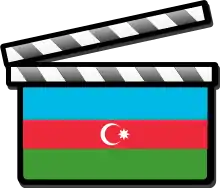 | |
| No. of screens | 17 (2011)[1] |
| • Per capita | 0.2 per 100,000 (2011)[1] |
| Produced feature films (2010)[2] | |
| Fictional | 9 (45.0%) |
| Animated | 2 (10.0%) |
| Documentary | 9 (45.0%) |
| Number of admissions (2011)[3] | |
| Total | 77,000 |
| National films | 6,600 (8.6%) |
| Gross box office (2011)[3] | |
| Total | AZN 364,800 |
| National films | AZN 6,000 (1.6%) |
| Part of a series on |
| Azerbaijanis |
|---|
| Culture |
| Traditional areas of settlement |
| Diaspora |
| Religion |
| Language |
| Persecution |
|
Early history

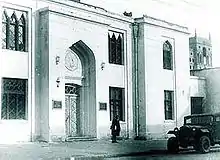
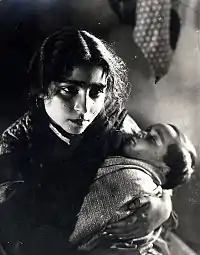
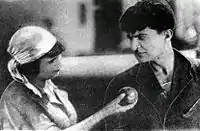

The film industry in Azerbaijan dates back to 1898. In fact, Azerbaijan was among the first countries involved in cinematography. When the Lumière brothers of France premiered their first motion picture footage in Paris on December 28, 1895, little did they know how rapidly it would ignite a new age of photographic documentation. These brothers invented an apparatus, patented in February 1895, which they called the "Cinématographe" (from which the word "cinematography" is derived). It is not surprising that this apparatus soon showed up in Baku – at the turn of the 19th century, this bay town on the Caspian was producing more than 50 percent of the world's supply of oil. Just like today, the oil industry attracted foreigners eager to invest and to work.[4]
A Frenchman by the name of Alexandre Michon was among the first entrepreneurs who came and settled in Baku. A photographer and cameraman by profession, he is believed to have lived in Baku for more than 25 years where he set up a photo studio. Mishon became active in forming a scientific photo circle in Baku and became its secretary. From 1879 to 1905, he documented landscapes, episodes from oil extraction, the refining process, as well as the oil gushers and terrifying fires that broke out in the oil fields. In 1898, Mishon began shooting motion pictures that depicted everyday life in Baku. It was his intention to exhibit them in Paris.
Michon's footages still exist up to date in the archives of the Union of Cinematographers of Azerbaijan. The Folk Dance of Caucasus was later used in a documentary, and the scenes from The Oil Gush Fire in Bibiheybat were shown in France in 1995, in a film commemorating the 100th anniversary of world cinema.
The Newspaper Announcement about Michon's films:
"On Sunday, August 2, 1898, A. Michon, will show some motion pictures that he has taken with a Lumière movie camera and which has been improved by the engineer Jules Carpentier. These films of the Caucasus and Central Asia have been prepared for the forthcoming International Paris Exhibition and will be presented only once in Baku at the V. I. Vasilyev-Vyatski Circus Theater.
"The following films will be shown: Fire resulting from an oil gusher at Bibi-Heybat oil field, Farewell Ceremony for His Majesty Emir of Bukhara on "Velikiy Kniaz Alexei" Steamboat, a folk dance of the Caucasus, and scenes from the comedy, 'So, You Got Caught,' which was performed recently in one of Baku's parks. For more detailed information, see the posters. The event starts at 21:00 (9 p.m.)."
The event was an enormous success and Michon repeated it on August 5, replacing the final two works with those showing life in Balakhani outside of Baku.
Michon's footage still exists. "Folk Dance of the Caucasus" was later used in a documentary and scenes from "Oil Gush Fire in Bibi-Heybat" were shown in France in 1995, in a film commemorating the 100th anniversary of world cinema. On November 27, 1899 writer, scientist and social activist Hasan Zardabi in the "Kaspi" entitled an article in which he wrote, "Now we have in our hands a toy machine-called "kinemato-graphe." This wonderful machine was produced only a short time ago and gives the impression of being just a toy. You can find this machine which is called 'stroboscope' in many optician shops."
Early 20th century
In 1915 the Pirone brothers of Belgium set up a film production laboratory in Baku. They invited film director Boris Svetlov from St. Petersburg (Russia) to work for them and produce The Woman, An Hour before His Death and An Old Story in a New Manner. It was Svetlov who also directed the film entitled In the Kingdom of Oil and Millions which later became so well known.[5] The famous Azerbaijani actor Huseyn Arablinski played Lutfali, the main role in this film.[4]
In 1916 The first version of the operetta "Arshin Mal Alan" was directed by Svetlov. During this era of "silent" film the musical selections were performed by in-house musicians. Two of the women's roles in the film were played by men. Gulchohra was played by Ahmad Aghdamski and Aunt Jahan was played by Y. Narimanov.
In 1919, during the short-lived Azerbaijan Democratic Republic, a documentary called The Celebration of the Anniversary of Azerbaijani Independence was filmed on Azerbaijan's independence day, May 28, and premiered in June 1919 at several theatres in Baku.[6]
Soviet period
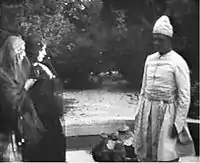
After the Soviet power was established in 1920, Nariman Narimanov, Chairman of the Revolutionary Committee of Azerbaijan, signed a decree nationalizing Azerbaijan's cinema. The People's Education Commissariat, which functioned somewhat like a Ministry, created an art department which included a film section headed by Hanafi Teregulov and Muslim Magomayev, a notable composer and opera singer. In 1922 the government of Azerbaijan decided to create the first cinema factory which became the forerunner of today's film studio Azerbaijanfilm.[4]
In 1923 the Azerbaijan Photo Film Institution (APFI) was established by a special decree of the Council of People's Commissars. The Institution controlled all the movie houses and distribution bureaus. Thus, a new epoch in the history of Azerbaijani cinema began – a period when Soviet ideology, not individual entrepreneurship, dominated the film industry.
APFI shot its first film The Maiden Tower Legend in 1924.[7] This film was the first Azerbaijani Soviet and was based on the legend about the Maiden Tower.
In the 1930s, Russian director Boris Barnet filmed By the Bluest of Seas in Azerbaijan. The film, which is set on one of the country's islands in the Caspian Sea, has received renown from modern film critics.[8][9][10][11][12][13][14]
The 1940s
In 1940 film directors Mikhail Mikhailov and Vladimir Yeremeyev shot a documentary titled Twentieth Spring on the occasion of the 20th anniversary of the establishment of the Soviet government in Azerbaijan. During World War II in 1941 and 1942 short sound movies "The Motherland's Son" and Bakhtiyar (film director A. Guliyev), which were devoted to heroes of Kamal Gasimov and Bakhtiyar Karimov were shot. In the same years “Sabuhi” reflectin the life and activity of Mirza Fatali Akhundov were created by film director A.I.Bek-Nazarov and Rza Tahmasib. In 1943 film directors G.V.Aleksandrov, R.Tahmasib and M.Mikayilov shot the three-part "One Family" and "The T-9 Submarine". These films were devoted to the heroism of sailors in the time of World War II. In 1940s a group of documentary film directors and operators went to the frontline and recorded soldiers' heroism. Between 1943 and 1945 "For Motherland" (I.Afandiyev), "Care" (A.Guliyev), and "Response to the letter” and "The Caspians" (G.V.Aleksandrov and N.I.Bolshakov) which was devoted Caspian sailors' heroism were shot. In 1945 film director Husein Seyidzade shot full-length documentary "Country of eternal fires" regarding with the 25th anniversary of establishment of the government of Soviet. In the same year musical comedy “Arshin Mal Alan” by U.Hajibeyov went on screen again. The film directors Rza Tahmasib and Nicolay Leshenko made a brilliant reality comedy keeping national style and sense of humor of Azerbaijan. The film achieved success not only in Azerbaijan and USSR, but in many countries around the world. “Arshin Mal Alan” was fetched the film directors R.Tahmasib and N.Leshenko, composer Uzeyir Hajibeyov, and actors Rashid Behbudov, Leyla Badirbayli, Adila Huseynzade, Munevver Kalantarli and Lutfali Abdullayev an award USSR State Prize in 1946. In post-war years newsreel "Young generation" and "Soviet Azerbaijan"(former name "Order-bear Azerbaijan") began to be issued.[15]
The 1950s
In the late 1940s and early 1950s Baku film studio`s main style was artistic-documentary and publicist. During this period "Fatali Khan" (1947, film director V.I.Dzigan) and "The Baku Lights" (1950, film directors I.V.Xeyfits, A.G.Zarkhi and R.Tahmasib) were shot. In the middle of the 1950s new stage of Azerbaijani films development began. Movie industry development led to the widening of their subjects during those years. Film subjects included mainly labor and life of workers, collective farmers and others. "Under The Broiling Sun" (1957, film director L.Safarov), "Black Stones" (1958, film director A.Quliyev), "The Shades Are A Creeping" (1958, film directors I.Afandiyev and Sh.Sheykhov), "His Large Heart" (1959, film director A.Ibrahimov), "A True Friend" (1959, T.Tagizade), "Could He Be Forgiven" (1960, film director Tahmasib), "Our Street" (1961, film director A.Atakishiyev), "A Large Pier" (1962, film director H.Ismayilov), "A Telephone Girl", "There Is Such An Island As Well" 1962,1963, film director H.Seyidbayli), "Stepmother" (1959, film director H.Ismayilov) are bright examples of Azerbaijani film that shot during these years. In 1950 colored full-length documentary "Soviet Azerbaijan" (film directors M.Dadashov, F.Kiselyov) was made on the occasion of 30th anniversary of Soviet government victory in Azerbaijan. This film won Cannes (France) international film festival special prize in 1951. "In the gulf named after S.M.Kirov", "He Who Searches Will Find" (1955, 1969, film directors S.Mammadov), "Along way of happiness" "Our Azerbaijan" (1957, 1959, film director M.Dadashov). "Baku and its residents" (1957, film director L.Safarov), "Spring of Azerbaijan culture" (1960, film directors Ch.Mammadov, Kh.Babayev), "M.F.Akhundov" (1962, film director N.Badalov) ."Epos about Caspian oil industry worker" (1953), and "Sea conquerors" (1959) were made by world fame film director R.L.Karmen in "Baki kinostudiyasi" (Baku film studio). He was awarded Lenin prize for these works (1960). "Two Boys Of The Same Block" (film directors A.Ibrahimov and I.V.Gurin, cameramen M.M.Pilikhina and R.Odjagov, compositor G.Garayev) is about an Eastern nation's struggle for freedom and democracy. "On Distant Shores", devoted to brave guerrilla Mehdi Huseynzade (1958, film director T.Tagizade), is one of the achievements of Azerbaijan, as well as former soviet film.
Cinema in the Azerbaijan Republic
In 1991, after Azerbaijan gained its independence from the Soviet Union, first Baku International Film Festival East-West was held in Baku. In December 2000, the former President of Azerbaijan, Heydar Aliyev, signed a decree proclaiming August 2 professional holiday of filmmakers of Azerbaijan.[16]
Now that the USSR does not exist anymore, Azerbaijani filmmakers are again dealing with issues similar to those faced by cinematographers prior to the establishment of the Soviet Union in 1920. Once again, both choice of content and sponsorship of films are largely left up to the initiative of the filmmaker.
In 1995, the director Rustam Ibrahimbeyov won an Academy Award for Burnt by the Sun as Best Foreign Film. This moment is described as one of the proudest event in Azerbaijan cinema history.[17]
References
- "Table 8: Cinema Infrastructure - Capacity". UNESCO Institute for Statistics. Retrieved 5 November 2013.
- "Table 1: Feature Film Production - Genre/Method of Shooting". UNESCO Institute for Statistics. Retrieved 5 November 2013.
- "Table 11: Exhibition - Admissions & Gross Box Office (GBO)". UNESCO Institute for Statistics. Retrieved 5 November 2013.
- Celebrating 100 Years in Film, not 80 by Aydin Kazimzade. Azerbaijan International, Autumn 1997.
- In the Kingdom of Oil and Millions at IMDb, 1916.
- "Azerbaijani cinema in 1920-1935: Silent films". OCAZ.eu.
- Qiz qalasi at IMDb, 1924.
- Anthony Nield (February 6, 2012). "By the Bluest of Seas". The Digital Fix. Archived from the original on June 10, 2016. Retrieved August 10, 2015.
- Jonathan Rosenbaum (February 6, 2004). "Glimpse of a Rare Bird [on Boris Barnet] (upgraded)". Jonathanrosenbaum.net. Archived from the original on August 15, 2016. Retrieved August 10, 2015.CS1 maint: bot: original URL status unknown (link)
- "Boris Barnet". National Film and Sound Archive. Retrieved August 10, 2015.
- Ben Nicholson. "DVD Review: Barnet's 'Outskirts' & 'Bluest of Seas'". Cine-vue.com. Retrieved August 10, 2015.
- Dennis Schwartz (January 21, 2015). "BY THE BLUEST OF SEAS (U SAMOGO SINEGO MORYA)". Ozus' World Movie Reviews. Archived from the original on December 11, 2017. Retrieved August 10, 2015.
- Friel, Patrick. "Home Movies: By the Bluest of Seas". Film Comment (January/February 2013). Retrieved August 10, 2015.
- Prof. Nicole Brenez (November 19, 2008). Nicole Brenez on By the Bluest of Seas (video) (in French). Also Like Life. Event occurs at 0:30. Retrieved August 17, 2015.
- "AZƏRBAYCAN KİNOSU 1935-1988-Cİ İLLƏRDƏ. SƏSLİ DÖVR"
- (in Russian) Azerbaijan Cinematographers Union Archived 2007-09-27 at the Wayback Machine Confederation of Cinematographers Unions
- Presentation of the Azerbaijan cinema on Eurochannel website
Bibliography
- Michael G. Smith, "Cinema for the Soviet East: National Fact and Revolutionary Fiction in Early Azerbaijani Film", Slavic Review Vol. 56 No. 4 (Winter 1997), pp. 645–678.
External links
| Wikimedia Commons has media related to Cinema of Azerbaijan. |
- "Cinema: Can it be Revived?" Entire issue of Azerbaijan International, Autumn 1997 (AI 5.3).
